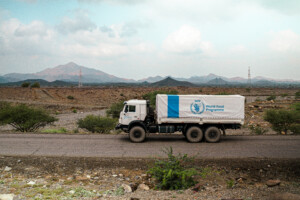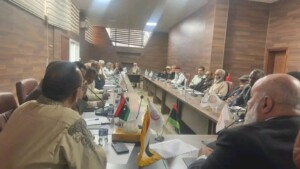Sudan OCHA bulletin 49: Aid supplies arrive in Jebel Marra’s Fanga Suk
The UN Office for the Coordination of Humanitarian Affairs (OCHA) in Sudan reports in its latest weekly bulletin that a convoy carrying humanitarian relief supplies arrived in Fanga Suk in Central Darfur’s Jebel Marra on 5 December.
The UN Office for the Coordination of Humanitarian Affairs (OCHA) in Sudan reports in its latest weekly bulletin that a convoy carrying humanitarian relief supplies arrived in Fanga Suk in Central Darfur’s Jebel Marra on 5 December.
The humanitarian needs of people in Fanga Suk were identified on 11 November, during the first inter-agency mission to the area since 2011.
The relief supplies were donated by the World Food Programme (WFP), the UN Children’s Agency (Unicef) and the World Health Organization (WHO), and included 487 metric tons of food, enough for 18,000 people for three months, emergency shelter and household supplies for 1,575 families (about 6,300 people), and water and sanitation supplies. Health supplies were also sent.
The supplies will be stored in the Sudanese Red Crescent Society (SRCS) warehouse until the International Organization for Migration (IOM) completes the verification and registration exercise, after which distributions will begin.
North Darfur’s Kokai village safe for returns
An estimated 200 families (800 people) would like to return from Saraf Umra town to their home areas in and around Kokai village. The village lies about 25km from the Unamid team site in Saraf Umra. A mission found the security situation in the area of Kokai calm and suitable for returns. The host community expressed an openness to the return of the displaced people and confirmed that they were originally from the area.
According to the mission findings, the return villages are in need of water points, schools, latrines and health centres. Aid agencies will meet to discuss an appropriate assistance plan.
Assessment of refugees in West Kordofan
From 24 to 30 November, aid organisations conducted an inter-agency assessment in West Kordofan upon the request of governmental Humanitarian Aid Commission (HAC).
The team visited the Kharasana refugee centre in Keilak locality, which hosts South Sudanese refugees and Et Tibbun village in Babanusa locality, which hosts both South Sudan refugees and displaced Sudanese who fled inter-tribal conflicts from other parts of the state and East Darfur in May.
The Kharasana reception centre is congested with 8,000 people having built shelters around it. The health centre in the area is overwhelmed by the influx of refugees. Both the refugees and health staff face communication problems as some of the refugees do not speak Arabic.
According to the mission findings, there are medical personnel among the refugee population who could support a health centre for the refugees. IOM and Unicef will drill a borehole at the site. The WHO will build a permanent health clinic inside the camp while UNHCR will build a reception centre.
In Et Tibbun village, the 2,350 displaced people and 3,900 refugees refugees have partially integrated into the community and have good access to land for agriculture. There is no government sponsored health clinic in the area. Existing water facilities require rehabilitation.
Only six out of 500 school-aged children attend school, mainly due to their inability to pay the school fees or buy a school uniform. Aid organisations are currently meeting to develop a response plan.
Dengue fever spreads to Kassala and Kordofan
According to the Ministry of Health, a total of 557 suspected dengue fever cases, including 130 deaths, were reported in Sudan between 29 August and 4 December.
The outbreak had initially affected Darfur but has now spread to Kassala and Kordofan states. The age group 5 to 14 years has the highest number of cases (45 percent).

In response, the WHO has sent an epidemiologist to support the Health Ministry in investigation and outbreak response. In West Darfur, the World Relief organisation ran five mobile clinics and received mosquito nets from the state Ministry of Health for distribution in four clinics in Kereinik locality. WHO and Médecins Sans Frontières-Switzerland supported a treatment centre in El Geneina, capital of West Darfur.
In East Darfur, UNnicef released three primary health care kits, enough for the needs of 30,000 people for three months. The WHO continued to support MoH in integrated vector control activities covering all affected localities in Darfur, Kassala and Kordofan states.
Annual CFSAM assessment arrives in South Darfur
On 1 December, the annual Crop and Food Supply Assessment Mission (CFSAM) started their assessment of the 2015 crop production as well as food availability and livestock conditions in South Darfur, after which it will move on to East Darfur.
The mission includes representatives of the Ministry of Agriculture, the Ministry of Animal Resources, the HAC and the World Food Programme.
Aid organisations are concerned that people in these areas may not have reliable access to food due to the poor rains and the long dry spell from late August into late September, caused by El Niño. As a result, a number of localities are likely to face a 30 to 40 percent decline in their harvest yields compared to the 2014 harvest.
Conflicts increase between pastoralists and farmers in South Darfur
According to aid organisations, there has been a recent increase in the number of incidents between pastoralists and farmers, mainly over the grazing of animals on farmland. Between February and June, northern localities in South Darfur State are traditionally areas for livestock grazing during the rainy season, according to the Food and Agriculture Organization (FAO).
Because of the low rains this year and subsequent poor pasture for grazing, pastoralists have started moving their herds southwards in November, which is earlier than usual. This has led to conflicts with farmers when the livestock graze on crops.
Additionally, pastures in areas in the south of the state will likely be depleted and will not sustain livestock up to the next rainy season, according to FAO. As pastoralist migration also exposes livestock to disease, FAO and the Ministry of Animal Resources are planning to procure 100,000 animal vaccines (enough for 500,000 heads of livestock). This, however, this is not enough to cover the livestock population in the area, which is estimated to be in the millions.
Read the full OCHA bulletin here











 and then
and then